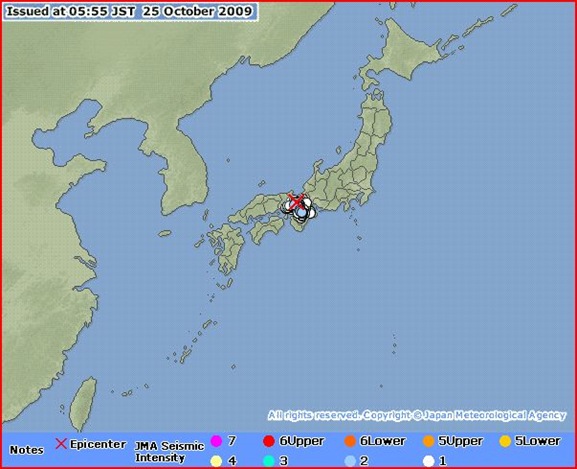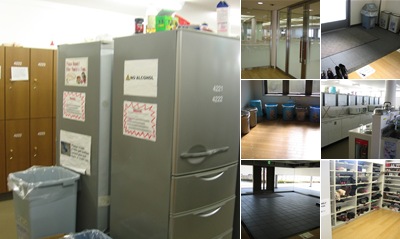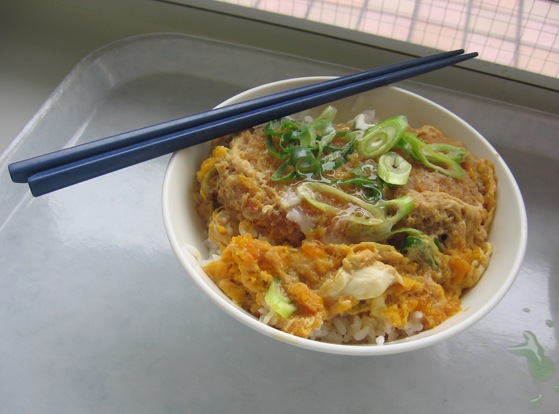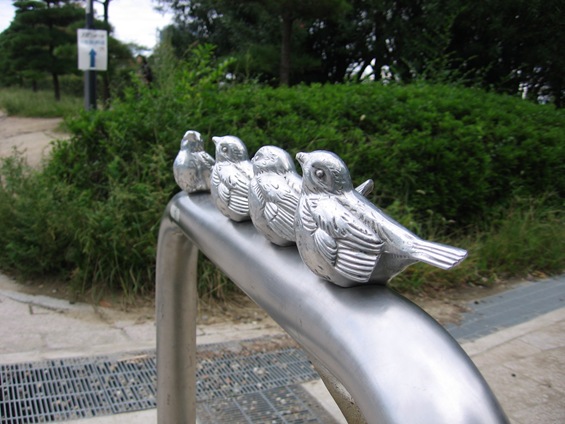
A lot has happened since my last post.
Today I travelled to the post office and Hirakata City to get my insurance and alien registration cards (a.k.a. gaijin-kaado). It’s sort of cemented the idea that I’m actually in Japan. It’s still a little unbelievable, even after a month and a half.
The rice harvest has occurred in Osaka and Kyoto – blatantly noticeable locally because there are several single fields of rice around Hirakata City. I’m unsure of why they’re grown within the city – but there are even fields around the local grocery stores. I wish I had gotten some pictures of the rice and the harvest, but it’s too late now. I noticed that workers would bundle the rice and hang the stalks on poles to dry out – I don’t know why, but I’m sure there’s a reason. All that’s left now of the verdant green fields is mud.
My Intercultural Business Communication Teacher, Dr. Reynolds, took some awesome pictures of a rice harvest festival in the nearby city of Nara, where he’s building a house. They can be found at this post here.
I was going to go with his class to Osaka for a conference with representatives from Georgia businesses (that’s the state of Georgia, not the country.) The representatives were going to be making presentations on doing business in Japan, and I was really psyched to go. I dressed up nicely, made sure I looked good, and everything. (I had two tests early that morning, and we were going to be leaving from the school that afternoon.) When I went down to the shoes room, I looked at my shelf thoughtfully. I didn’t want to wear flip-flops with my outfit, and I knew I was going to wear my heels in Osaka. In order to not have a bag with shoes in it while meeting people in Osaka, I decided not to wear comfortable shoes to school.
Boy, was that a bad idea.
It takes about a half-hour to walk to school from the seminar house, which in my pace is in the vicinity of a mile. A mile in high heels that I hadn’t worn for months. By the time I realized the predicament I was in, it was too late to turn back and make it to school on time. When I got to school, I knew I wasn’t going to be going to Osaka. It was painful enough to move around the school, let along go anywhere else. I have blisters running up and down my feet and the backs of my heels are gone. Ouch! So a pair of high heels got between me and fun.
I mentioned in my previous post that I’d been to Osaka on Saturday. That was for a field trip for my Peace and Human Rights class. We went to the Peace Museum there – I knew it would be an interesting experience. As the teacher, Dr. Scott says – “When you’re the victor in a war, you build war museums, but when you don’t win, you build peace museums.” The center was very nice and dramatic – with an insightful view of the firebombings of Osaka. The museum never mentioned much about the aggressors in the war – Dr. Scott pointed out that in all the exhibits, it’s shown that for civilians, no country was the enemy. War is considered the enemy. Here’s the outside of the museum:
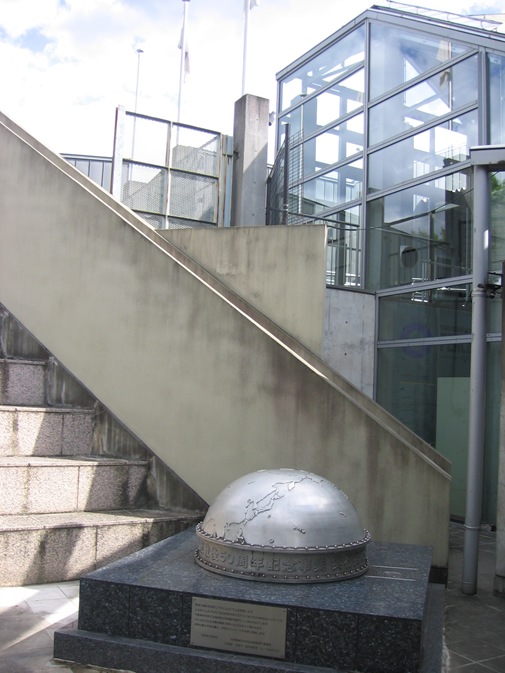
It’s difficult to discern from the architecture, but from the exhibits it was quite obvious that the museum was built in the late 1980s. Unfortunately, it wasn’t too up-to-date, so there was still a bit of a Cold War feel to the place when it talked about current events and nuclear proliferation.
After going to the museum, we were free to do whatever we wanted. Lisa, who went with us to Kyoto, was in that class and we decided to go around Osaka. The Peace Museum is located on the fringes of a park surrounding a famous castle in the middle of Osaka. The castle was destroyed several times, so I’ve been told that the inside was incredibly modern and disappointing. However, from the battlements above the moats, there were still some nice views:

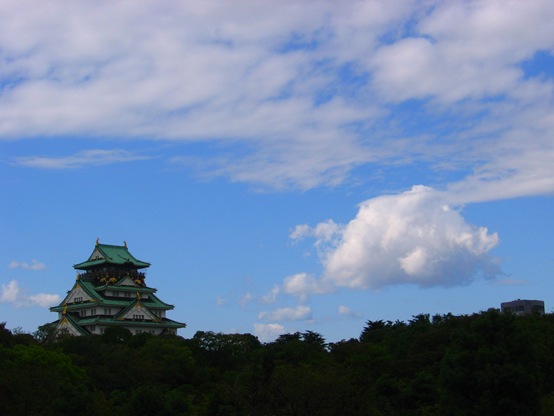
The castle park was very nice, forested, with fountains and open-air markets. The park is noted for housing many homeless people, and their blue-tarp tents could be seen through the trees. (I’ll post about homeless later.)
The picture at the beginning of this post is from that park.
After the park, we went into the more built-up parts of Osaka. We went to Nihonbashi, which is close to Nanba, the place I went to before. Nihonbashi is a place reputed to be filled with geeky foreigners and people dressed up, but under the afternoon sun, the place looked incredibly ordinary. No strange people at all. From there we walked to Nanba. Nanba is a totally different place in the afternoon than at night – quiet, with no glitzy lights and restaurants just beginning to open.
We must’ve walked past Nanba because we came to an interesting place – a shopping mall covered in verdant foliage. 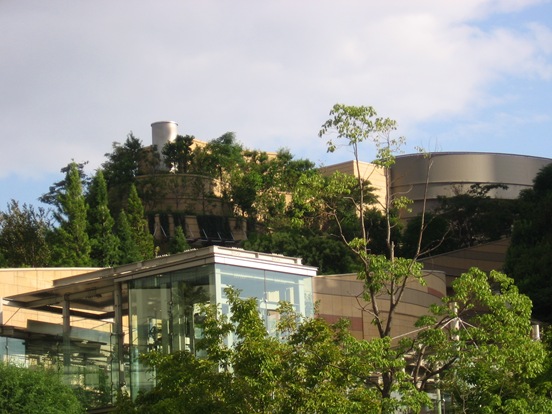
When we went inside, it was apparent that the place catered to people of higher socioeconomic status. Names like Chanel could be seen floating around, and the place seemed fairly new. It was obvious that something was going on – a stage was set up, and people were lined up towards the stage. When we got a better look, we found that people were lined up to shake hands (not get autographs) with a J-Pop star, Jewel. Neither of us knew who she was, but I’m fairly sure the hundreds of other people did. Picture-taking was greatly discouraged, but people on the higher floors overlooking the plaza were taking lots of pictures. We went in some of the stores and wandered around, finding an interesting store called “Lush” that sold handmade beauty products. It was very difficult to understand in Japanese what the products did! But the store was cool.
As the sun began to set, we wandered some more around the glitzy, head banging Nanba. I searched for the awesome takoyaki place, but was unable to find it. The sun ducked below the horizon, and the streets came to life – the neon lights, the quirky people, and after a couple hours we headed home. Overall, we definitely had a fun time.
Since then, I’ve been trying to decide where to go next. I haven’t seen nearly enough of Kyoto, and we’re heading into the time where the fall foliage will be peaking – and the Japanese maples will turn brilliant red. I’ve discovered the awesomeness that is WikiTravel, and I’m thinking of seeing some places related to the famous haiku poet, Basho. He’s very famous for writing a travelogue covering a lot of the main island here.
There are also a lot of other places to go – Nara, with old temples, Uji, which is famous for being the birthplace of the Tale of Genji. There are lots of beautiful places around!
One last thing – I promised a video of cute baby sea otters. Here it is – taken by my friend, Ami Higashi. In the background, you can hear people saying, “Kawaii!” – which means cute, or adorable, in Japanese.
